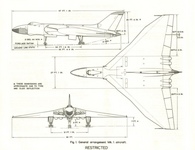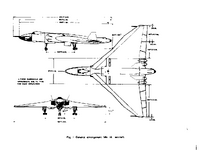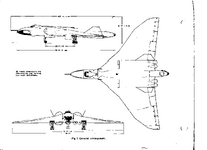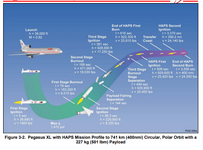m13katyusa2020
Senior Airman
- 472
- Mar 26, 2022
Vulcan Bomber was the 1st generation bomber of Britain, which was the only jet heavy bomber which have been kept for air show after its retirement for 30 years.
However, after the bankrupt of the vulcan-keeping company for air show and the age of vulcan, it is not capable for flight after 2015.
Its main shortage was its short range, only capable within Europe, and the range too short for other countries.
For example, other bombers could cruise for at least 8000km, but vulcan could only cruise 4800km.
However theoretically bombers have some civil usage possibilities, which is better than other civil aircrafts.
When used in war, it could ruin lives, but for civil usage, it could save lives. In the following post of the thread, I would post some possible civil usages of bomber, which are special but with a great potential.
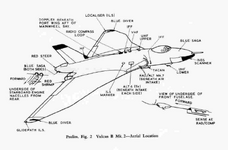
In the first post of the thread, there will be Vulcan mk.2 Flight Manual(AFM), Maintenance Manual(AMM), SRM and IPC.
All of the Vulcan 2 manuals are in this folder:
 u.pcloud.link
alternate link:
u.pcloud.link
alternate link:

 www.mediafire.com
or here:
www.mediafire.com
or here:

 www.mediafire.com
www.mediafire.com
another alternate link with access code 1234
Vulcan mk.2 Aircrew Manual(AFM) here:
 u.pcloud.link
alternate link:
u.pcloud.link
alternate link:
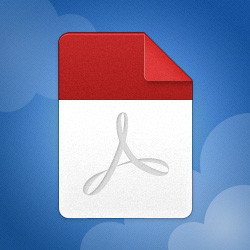 Vulcan mk.2 AMM(Maintenance Manual in 6 volumes, with 2 volumes of Electronic manuals):
Vulcan mk.2 AMM(Maintenance Manual in 6 volumes, with 2 volumes of Electronic manuals):
 u.pcloud.link
u.pcloud.link
 u.pcloud.link
u.pcloud.link
 u.pcloud.link
u.pcloud.link
 u.pcloud.link
u.pcloud.link
 u.pcloud.link
u.pcloud.link
 u.pcloud.link
alternate links:
u.pcloud.link
alternate links:






alternate link with access code 1234
Vulcan mk.2 SRM(Structural Repair Manual) here:
 u.pcloud.link
alternate link:
u.pcloud.link
alternate link:

Volcan Mk.2 IPC(Illustrated Parts Catalogue) here:
 u.pcloud.link
alternate link:
u.pcloud.link
alternate link:

another alternate link with access code 1234
Disclaimer: These items are shared for historical reference, sharing for non-profitable use only.
This manuals and blueprints are not meant to be used for current update material for certification / repair, but make an excellent reference for the scholar, collector, modeler or aircraft buffs .... For proprietary reasons we generally only provide manuals on long-time out-of-production Aircraft / Engines / Helicopter. The information is for reference only and we do not guarantee the accuracy or currency of any manuals.
Reference herein to any specific commercial products by trade name, trademark, manufacturer, or otherwise, is not meant to imply or suggest any endorsement by, or affiliation with that manufacturer or supplier. All trade names, trademarks and manufacturer names are the property of their respective owners.
However, after the bankrupt of the vulcan-keeping company for air show and the age of vulcan, it is not capable for flight after 2015.
Its main shortage was its short range, only capable within Europe, and the range too short for other countries.
For example, other bombers could cruise for at least 8000km, but vulcan could only cruise 4800km.
However theoretically bombers have some civil usage possibilities, which is better than other civil aircrafts.
When used in war, it could ruin lives, but for civil usage, it could save lives. In the following post of the thread, I would post some possible civil usages of bomber, which are special but with a great potential.

| B.1 | B.1A | B.2 | B.2 (MRR) | K.2 |
|---|---|---|---|---|
| Wingspan | 99 ft 5 in (30.30 m) | 111 ft 0 in (33.83 m) | ||
| Length | 97 ft 1 in (29.59 m) | 105 ft 6 in (32.16 m) [99 ft 11 in (30.45 m) without probe] | ||
| Height | 26 ft 6 in (8.08 m) | 27 ft 1 in (8.26 m) | ||
| Wing area | 3,554 sq ft (330.2 m2)[251] | 3,964 sq ft (368.3 m2)[251] | ||
| Max. takeoff weight | 167,000 lb (76,000 kg) 185,000 lb (84,000 kg) (operational necessity) | 204,000 lb (93,000 kg) | ||
| Cruising speed | Mach 0.86 indicated | |||
| Max. speed | Mach 0.95 indicated | Mach 0.93 indicated (Mach 0.92 with 301 engines) | Mach 0.93 indicated | Unknown |
| Service ceiling | 55,000 ft (17,000 m)[251] | 45,000 to 56,000 ft (14,000 to 17,000 m)[nb 2] | ||
| Electrical system | 112 V DC | 115/200 V AC 3-phase 400 Hz | ||
| Emergency electrical system | Battery | Ram air turbine and Airborne Auxiliary Power Plant | ||
| Engines | 4 × Bristol Olympus 101, 102 or 104, 58kN each | 4 × Bristol Olympus 104, 58kN each | 4 × Bristol Siddeley Olympus 200-series, 301, 78kN each | 4 × Bristol Siddeley Olympus 200-series, 78kN each |
| Fuel capacity (main) | 9,280 imp gal (11,140 US gal; 42,200 l) / 74,240 lb (33,675 kg) avtur)[nb 3] | 9,260 imp gal (11,120 US gal; 42,100 l) / 74,080 lb (33,602 kg) | ||
| Fuel capacity (bomb bay) | None | 0–1,990 imp gal (0–2,390 US gal; 0–9,047 l) / 0–15,920 lb (0–7,221 kg) | 1,990 imp gal (2,390 US gal; 9,000 l) / 15,920 lb (7,221 kg)[nb 4] | 2,985 imp gal (3,585 US gal; 13,570 l) / 23,880 lb (10,832 kg)[nb 5] |
| Powered flying controls | 1 × rudder (duplex), 4 × elevators, 4 × ailerons | 1 × rudder (duplex), 8 × elevons | ||
| Armament | 1 × free-fall nuclear bomb or 21 × 1,000 lb (450 kg) conventional bombs | 1 × Blue Steel missile or 1 × free-fall nuclear bomb or 21 × 1,000 lb (450 kg) conventional bombs | None |
In the first post of the thread, there will be Vulcan mk.2 Flight Manual(AFM), Maintenance Manual(AMM), SRM and IPC.
All of the Vulcan 2 manuals are in this folder:
PUBLIC-VULCAN-MANUAL-LOW-RESOLUTION-FOR-TRAIL - Shared with pCloud
Keep all your files safe, access them on any device you own and share with just the right people. Create a free pCloud account!

MediaFire
MediaFire is a simple to use free service that lets you put all your photos, documents, music, and video in a single place so you can access them anywhere and share them everywhere.

MediaFire
MediaFire is a simple to use free service that lets you put all your photos, documents, music, and video in a single place so you can access them anywhere and share them everywhere.
another alternate link with access code 1234
Vulcan mk.2 Aircrew Manual(AFM) here:
AP4505B-V15_Aircrew_Manual.pdf - Shared with pCloud
Keep, share and access your files whenever you need from wherever you are. Create a free pCloud account and make your life easier.

AP4505B-V15_Aircrew_Manual
MediaFire is a simple to use free service that lets you put all your photos, documents, music, and video in a single place so you can access them anywhere and share them everywhere.
www.mediafire.com
AP4505B-V1B1-Service_1of2_General.pdf - Shared with pCloud
Keep, share and access your files whenever you need from wherever you are. Create a free pCloud account and make your life easier.
AP4505B-V1B1-Service_2of2_Airframe.pdf - Shared with pCloud
Keep, share and access your files whenever you need from wherever you are. Create a free pCloud account and make your life easier.
AP4505B-V1B2-Service_EI_1of2.pdf - Shared with pCloud
Keep, share and access your files whenever you need from wherever you are. Create a free pCloud account and make your life easier.
AP4505B-V1B2-Service_EI_2of2.pdf - Shared with pCloud
Keep, share and access your files whenever you need from wherever you are. Create a free pCloud account and make your life easier.
AP4505B-V1B3_1OF2-Vulcan_elec_device_install_manual_2differentDATE_Versions.pdf - Shared with pCloud
Keep, share and access your files whenever you need from wherever you are. Create a free pCloud account and make your life easier.
AP4505B-V1B3_2OF2-VulcanMk2EWinstall.pdf - Shared with pCloud
Keep, share and access your files whenever you need from wherever you are. Create a free pCloud account and make your life easier.

AP4505B-V1B1-Service_1of2_General
MediaFire is a simple to use free service that lets you put all your photos, documents, music, and video in a single place so you can access them anywhere and share them everywhere.
www.mediafire.com

AP4505B-V1B1-Service_2of2_Airframe
MediaFire is a simple to use free service that lets you put all your photos, documents, music, and video in a single place so you can access them anywhere and share them everywhere.
www.mediafire.com

AP4505B-V1B2-Service_EI_1of2
MediaFire is a simple to use free service that lets you put all your photos, documents, music, and video in a single place so you can access them anywhere and share them everywhere.
www.mediafire.com

AP4505B-V1B2-Service_EI_2of2
MediaFire is a simple to use free service that lets you put all your photos, documents, music, and video in a single place so you can access them anywhere and share them everywhere.
www.mediafire.com

AP4505B-V1B3_1OF2-Vulcan_elec_device_install_manual_2differentDATE_Versions
MediaFire is a simple to use free service that lets you put all your photos, documents, music, and video in a single place so you can access them anywhere and share them everywhere.
www.mediafire.com

AP4505B-V1B3_2OF2-VulcanMk2EWinstall
MediaFire is a simple to use free service that lets you put all your photos, documents, music, and video in a single place so you can access them anywhere and share them everywhere.
www.mediafire.com
alternate link with access code 1234
Vulcan mk.2 SRM(Structural Repair Manual) here:
AP4505-V6A-Vulcan-structural-repair-manual.pdf - Shared with pCloud
Keep, share and access your files whenever you need from wherever you are. Create a free pCloud account and make your life easier.

AP4505-V6A-Vulcan-structural-repair-manual
MediaFire is a simple to use free service that lets you put all your photos, documents, music, and video in a single place so you can access them anywhere and share them everywhere.
www.mediafire.com
Volcan Mk.2 IPC(Illustrated Parts Catalogue) here:
AP4505B-V3-SPM-VulcanB2-later.pdf - Shared with pCloud
Keep, share and access your files whenever you need from wherever you are. Create a free pCloud account and make your life easier.

AP4505B-V3-SPM-VulcanB2-later
MediaFire is a simple to use free service that lets you put all your photos, documents, music, and video in a single place so you can access them anywhere and share them everywhere.
www.mediafire.com
another alternate link with access code 1234
Disclaimer: These items are shared for historical reference, sharing for non-profitable use only.
This manuals and blueprints are not meant to be used for current update material for certification / repair, but make an excellent reference for the scholar, collector, modeler or aircraft buffs .... For proprietary reasons we generally only provide manuals on long-time out-of-production Aircraft / Engines / Helicopter. The information is for reference only and we do not guarantee the accuracy or currency of any manuals.
Reference herein to any specific commercial products by trade name, trademark, manufacturer, or otherwise, is not meant to imply or suggest any endorsement by, or affiliation with that manufacturer or supplier. All trade names, trademarks and manufacturer names are the property of their respective owners.
Last edited:

